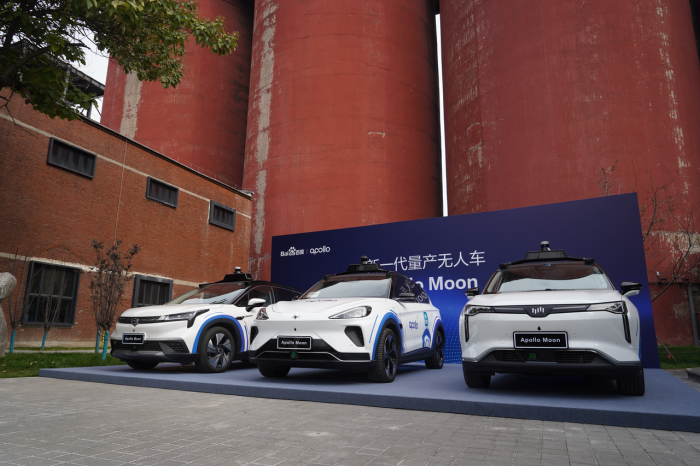Author: Yur
In the 1990s, being a driver was an enviable job. It carried the career of the previous generation. With the passage of time, autonomous driving technology is gradually emerging, and “driverless” will become the norm in the future transportation industry. Robotaxi services are penetrating into people’s lives.
Three elements, three models, three times the speed
At the Apollo Day technology open day, the number “three” was mentioned many times. Since Baidu started the Apollo project, the three elements of “front-loading mass-produced cars”, “AI old drivers”, and “5G cloud driving” have been continuously innovating and evolving.
From the previous single model of the fourth generation to three current models of the fifth generation: Apollo Moon Xtreme Fox version, WmAuto version, and Aian version. The automatic driving safety test mileage has also increased from 6 million kilometers to 18 million kilometers, completing three times the test mileage improvement. The initial 5G cloud driving has expanded from a single remote rescue scene to three practical scenarios of “travel services, special operation scenarios, and smart city services”.
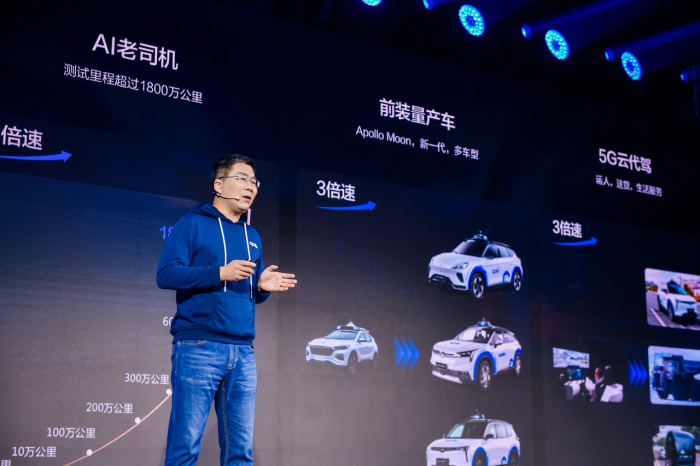
Among them, the total cost of Apollo Moon Xtreme Fox version, the entire vehicle, and unmanned driving kit is 480,000 yuan, which has caused a stir. It is noteworthy that most companies in the Robotaxi field domestically and abroad are restricted by the cost of lidars, computational chips, and other components, and the cost of each car is in the million-yuan range.
The Apollo Moon Xtreme Fox version is a mass-produced car equipped with a lidar solution. Its self-developed computing unit has a computational power of 800 TOPS, equipped with 13 cameras, 5 millimeter-wave radars, and 2 lidars. At the same time, the roof is loaded with a customized lidar from Velodyne, and there is a safety backup lidar forward. Based on the “ANP-Robotaxi” architecture dominated by visual perception algorithms, it ultimately reduces its reliance on expensive components and compresses manufacturing costs to 480,000 yuan.
According to official statements, this is equivalent to one-third of the average cost of L4 autonomous driving models in the industry.
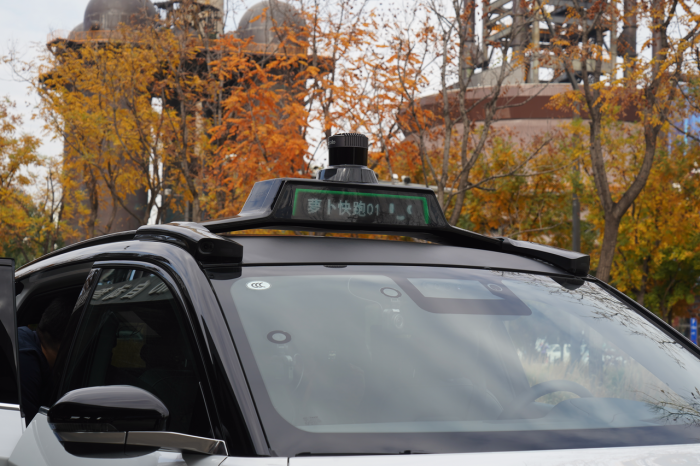 Controllable vehicle cost can also reduce vehicle operation cost. Calculated with a 5-year operation cycle, after a one-time investment of 480,000 yuan, the monthly vehicle operation cost is only 8,000 yuan, which not only saves the driver’s labor costs but also approaches the operating range of online car-hailing services. Of course, through 5G cloud driving, it also greatly reduces labor operation costs and efficiently improves vehicle services. The first few generations of front-end mass-produced vehicles needed to be equipped with safety officers to personally supervise the site, with one service per vehicle.
Controllable vehicle cost can also reduce vehicle operation cost. Calculated with a 5-year operation cycle, after a one-time investment of 480,000 yuan, the monthly vehicle operation cost is only 8,000 yuan, which not only saves the driver’s labor costs but also approaches the operating range of online car-hailing services. Of course, through 5G cloud driving, it also greatly reduces labor operation costs and efficiently improves vehicle services. The first few generations of front-end mass-produced vehicles needed to be equipped with safety officers to personally supervise the site, with one service per vehicle.
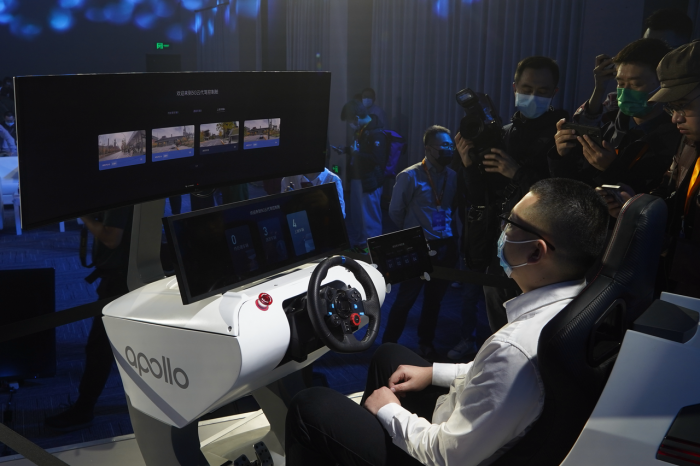
After upgrading to 5G cloud driving, the safety officer at the control center can control multiple unmanned vehicles with just one cockpit. In scenes where Apollo Moon cannot pass, they can complete remote assistance in time to return the vehicle to automatic driving mode.
Apollo Moon has the potential for initial commercial operation, and Baidu is targeting the field of autonomous driving travel services. In the current trend, the Robotaxi market is expected to exceed 13 trillion yuan. In the next 3 years, the operating range of Apollo Moon will be expanded to 30 cities, 3,000 additional front-loading vehicles, serving 3 million users. This is Baidu’s “small goal” for the Robotaxi field, which is difficult for its competitors to match.
Initial Experience with Apollo Moon
Ginkgo leaves scatter at Beijing Shougang Park. After four months of debugging, the Apollo Moon Arctic Fox Edition was officially opened for experience in the park. Without the guidance of an “old driver”, this five-minute, three-kilometer journey is full of “futuristic” feelings.
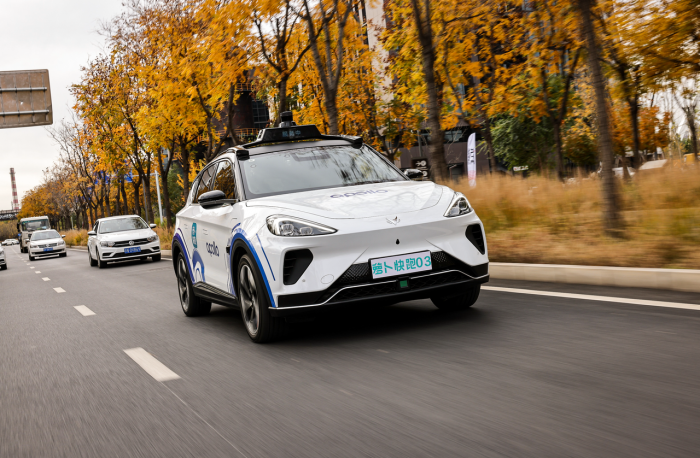
Putting an elephant into the refrigerator requires three steps. Riding Apollo Moon also requires three steps. First, register and install Baidu’s “Luobo Kuai Pao” app on our mobile phone, and use this software to select a point-to-point travel route.
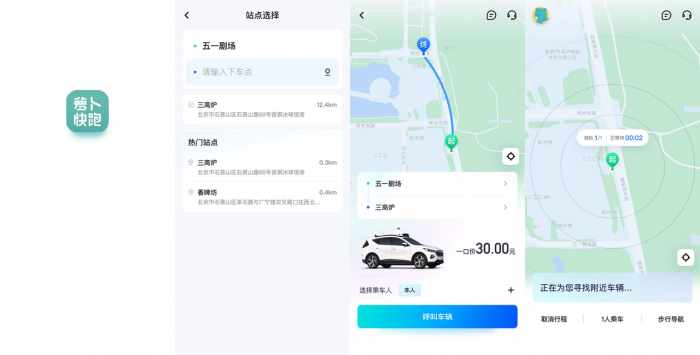
After waiting for a few minutes, Apollo Moon will slowly park at the starting point. As the fifth-generation Apollo Moon belongs to a completely unmanned driving mode, the driver’s seat and the front passenger’s seat are not equipped with safety officers, nor do they support passenger entry.Passengers only need to enter the last four digits of their phone number on the LCD touchscreen beside the C column to confirm their identity, and the rear door will automatically unlock and open, creating a very ceremonial entrance. Once inside the car, fasten your seat belt according to the prompt tone, and then click “Start Journey” on the rear screen. Apollo Moon will activate the autonomous driving function for an unmanned driving journey.
During takeoff, Apollo Moon will automatically signal a left turn and analyze the surrounding traffic situation to ensure the safety of the vehicle before merging onto the main road.
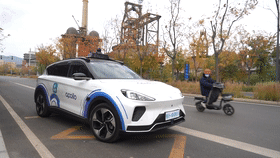
After driving straight for a while, Apollo Moon arrives at a busy intersection, where it slows down and signals a left turn before slowly turning into the center of the intersection. Following the rule of yielding to oncoming traffic when making a left turn, Apollo Moon stops and waits for the oncoming cars to pass before accelerating away from the intersection.
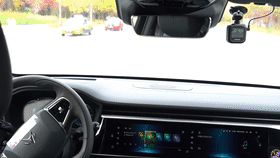
Apollo Moon is equally adept at dynamic pedestrian prediction. When the vehicle needs to make a U-turn, it first signals a left turn and slows down. At this point, a curious pedestrian stops on the zebra crossing to snap a photo with their phone. The sensor detects the pedestrian ahead, and Apollo Moon stops the car and patiently waits for the pedestrian to cross. After the pedestrian leaves, the vehicle continues its U-turn and merges slowly back onto the main road.
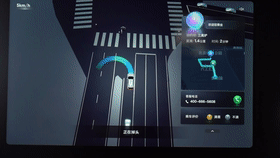
For Apollo Moon, it “thinks” more comprehensively than humans. In some difficult decision-making situations, it is more conservative, slowing down or braking in advance and always prioritizing safety.
Switching to the passenger’s perspective, the central area is equipped with a display screen to show vehicle information. The front seats are moved to the foremost position, leaving a “surplus” of space in the back.
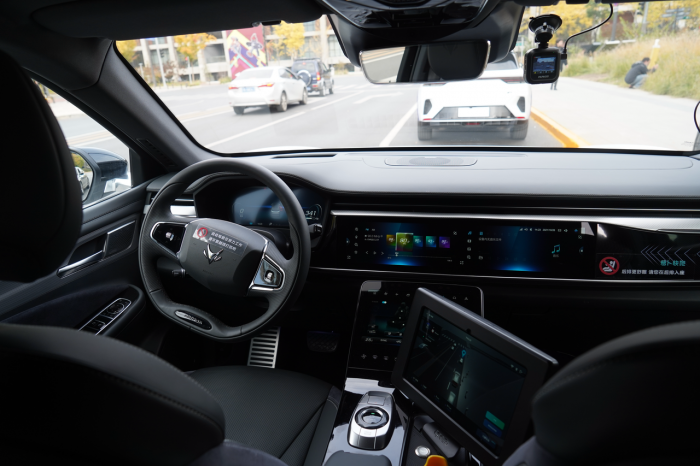
The roof-mounted LiDAR continuously detects the surrounding environment, oncoming traffic lanes, and pedestrian information, accurately mapping it onto the rear display screen without any delay. A small detail worth noting is that the roadside trees can also be displayed on the map.
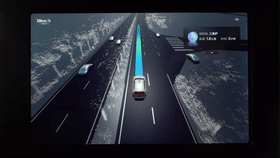 The current speed, destination, remaining distance and time are displayed in text at the top right corner of the screen. However, entertainment controls such as listening to radio or music have not been integrated into the screen yet, which may make the journey boring for friends who like to chat with drivers.
The current speed, destination, remaining distance and time are displayed in text at the top right corner of the screen. However, entertainment controls such as listening to radio or music have not been integrated into the screen yet, which may make the journey boring for friends who like to chat with drivers.
When approaching the destination, Apollo Moon, like a “master driver”, will decrease the speed, turn on the right turn signal, confirm that the parking spot is accessible before unlocking the doors, and voice prompt passengers not to leave their belongings behind. At the end of the journey, passengers can complete the experience by paying the fees through the “LuoBoKuaiPao” app.
Smoothness is the dominant feeling when riding on Apollo Moon Arctic Fox edition, with a speed of about 30-40 km/h and a distance of 3-5 meters maintained with the front vehicle. During the automatic driving process, the vehicle control is very linear with no dizziness, and it handles obstacles cautiously by braking in advance, changing lanes, or waiting for the front vehicle to leave. It is as stable as a new driver with a license.
If the vehicle encounters a complex environment that makes it unable to proceed, Apollo Moon will remind the user to authorize the 5G cloud driver. The remote driver will assist Apollo Moon to escape from the scene and return to autonomous driving mode. However, the scenery of Shougang Park is relatively simple, and I have not experienced the 5G cloud driving function this time.
The journey experience is excellent, and I have two suggestions for Apollo Moon. Firstly, the waiting time for “LuoBoKuaiPao” to call for the vehicle is relatively long, and it takes some patience to experience Apollo Moon. Secondly, whether the front and rear rows can install gear locks to prevent “curious” passengers from twisting the steering wheel and causing accidents. Finally, can the experience of Apollo Moon be as smooth as in the daytime during night with poor lighting and more surrounding vehicles?
Do you believe in autonomous driving?People are accustomed to conventional things, and when new things emerge, they conflict with the default things in their awareness, and instinctively choose to resist. Apollo Moon also faces this problem. Despite Baidu’s various anthropomorphic interactions inside and outside the vehicle to allow passengers and pedestrians to fully understand the information of the vehicle, it still causes some people’s psychological rejection. In fact, a simple analysis will reveal that Apollo Moon is more rational than manual driving, or it is more “low-key” than human driving.
First, Apollo Moon does not have human “road rage” problems such as emotions and fatigue, which reduces the risk of accidents to a certain extent. Second, it will not suddenly rush due to some efficiency issues and does not comply with traffic rules. Third, as we experienced earlier, it is more meticulous in detecting surrounding things than humans, always prioritizing safety. Therefore, Baidu needs to open up more pilot areas to let people have more frequent contact with Apollo Moon and improve their trust in it.
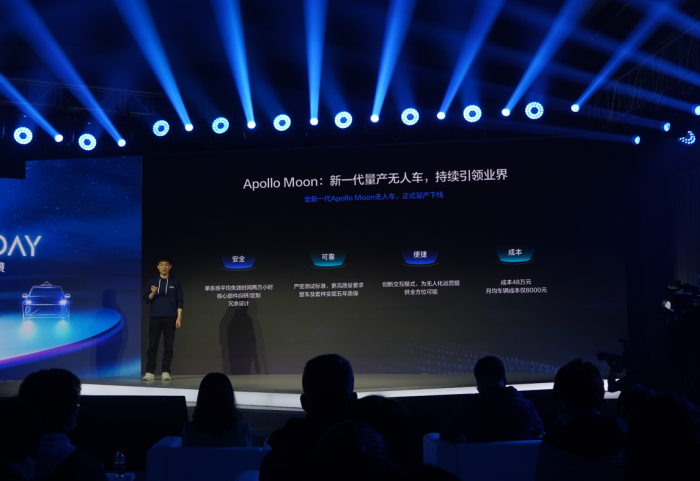
First half? Second half?
The first half of Robotaxi has ended, and players with automatic driving technology that “failed the test” have been eliminated.
Take Waymo as an example. More than ten years ago, it began developing autonomous driving technology within Google. At first, people’s impression of Waymo was that it had the ability to achieve large-scale production in a short period of time, but after years of research and development, it still faces many problems in the second half of Robotaxi. Its main direction is to seize the online car-hailing market instead of competing with peers. If there is no advantage in vehicle cost and user acceptance, commercialization will become a miniature.
Apollo Moon relies on its own cost advantage, total volume advantage, and 5G cloud-driven service advantage to vigorously promote the commercialization of Robotaxi. Baidu Apollo also serves transportation, logistics, smart agriculture, and other fields, as Li Yanhong advocates, the “Intelligent Economy” will be one of Baidu’s labels in the next ten years.
This article is a translation by ChatGPT of a Chinese report from 42HOW. If you have any questions about it, please email bd@42how.com.
